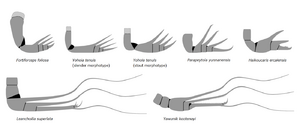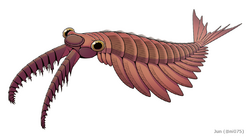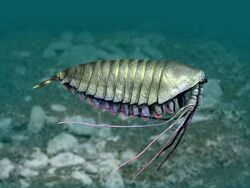Biology:Great appendage

Great appendages are claw-like appendages which attach to the heads of the "great appendage arthropods", a name usually refers to Megacheira, a class of extinct arthropod characterized by a pair of "short-great appendages" bearing in front of the animal's head.[1]
In general, megacheiran's great appendage have 6 segments, with the two proximal segments forming a peduncle and the four finger-like distal segments forming a claw, both connected by an elbow joint.[2] Great appendages have been interpreted as raptorial limbs involved in predation, with those of some genera such as Yohoia being structurally comparable to the raptorial maxillipeds of mantis shrimp.[2] The great appendages of leanchoilid megacheirans such as Leanchoilia and Yawunik have elongated flagella, suggesting a sensory role alongside predatory function.[3]

Radiodont's frontal appendages have controversial relationships to those of the megacheirans. They have been suggested to be homologous with the antennule of the euarthropods ("true" arthropods that differ from the stem-groups like radiodonts),[4] or more specifically the chelicerae of chelicerates,[2][5] although the latter possibility has been discounted by some authors.[6][7] As of late 2010s, most studies reject the homology of this two type of frontalmost appendages, with neural structures clarifying the segmental affinities of radiodont frontal appendages as protocerebral (homologous to euarthropod's labrum),[8] and megacheiran's short-great appendages as deutocerebral (homologous to euarthropod's antennule and chelicerae).[1] Similar appendages have also been found in other Cambrian arthropods such as Isoxys and Occacaris, but their segmental affinities remain conjectural.[1] On the other hand, some 2020 studies suggested that the frontalmost appendages of radiodonts and euarthropods may be homologous, and that the presence of a raptorial, deutocerebral frontalmost appendage is the ancestral condition for euarthropod itself.[9][10] Under this scenario, the euarthropod Kylinxia zhangi with frontalmost appendages that possess strong resemblance to those of a radiodont may represent an intermediate form between stem and true arthropods.[10]
References
- ↑ 1.0 1.1 1.2 Ortega-Hernández, Javier; Janssen, Ralf; Budd, Graham E. (2017-05-01). "Origin and evolution of the panarthropod head – A palaeobiological and developmental perspective". Arthropod Structure & Development. Evolution of Segmentation 46 (3): 354–379. doi:10.1016/j.asd.2016.10.011. ISSN 1467-8039. PMID 27989966.
- ↑ 2.0 2.1 2.2 Haug, Joachim T.; Waloszek, Dieter; Maas, Andreas; Liu, Yu; Haug, Carolin (March 2012). "Functional morphology, ontogeny and evolution of mantis shrimp-like predators in the Cambrian: MANTIS SHRIMP-LIKE CAMBRIAN PREDATORS" (in en). Palaeontology 55 (2): 369–399. doi:10.1111/j.1475-4983.2011.01124.x.
- ↑ Aria, Cédric; Caron, Jean-Bernard; Gaines, Robert (2015). "A large new leanchoiliid from the Burgess Shale and the influence of inapplicable states on stem arthropod phylogeny". Palaeontology 58 (4): 629–660. doi:10.1111/pala.12161.
- ↑ Stein, Martin (2010). "A new arthropod from the Early Cambrian of North Greenland, with a 'great appendage'-like antennula". Zoological Journal of the Linnean Society 158 (3): 477–500. doi:10.1111/j.1096-3642.2009.00562.x.
- ↑ Dornbos, Stephen; Bottjer, David; Chen, Jun-Yuan (2004). "Evidence for seafloor microbial mats and associated metazoan lifestyles in Lower Cambrian phosphorites of Southwest China". Lethaia 37 (2): 127–137. doi:10.1080/00241160410004764. https://pantherfile.uwm.edu/sdornbos/www/PDF%27s/Dornbos%20et%20al.%202004.pdf.
- ↑ Jager, Muriel; Murienne, Jérôme; Clabaut, Céline; Deutsch, Jean; Le Guyader, Hervé; Manuel, Michaël (2006). "Homology of arthropod anterior appendages revealed by Hox gene expression in a sea spider". Nature 441 (7092): 506–508. doi:10.1038/nature04591. PMID 16724066. Bibcode: 2006Natur.441..506J.
- ↑ Myers, PZ (May 26, 2006). "Chelifores, chelicerae, and invertebrate evolution". Pharyngula. http://scienceblogs.com/pharyngula/2006/05/26/chelifores-chelicerae-and-inve/.
- ↑ Peiyun Cong; Xiaoya Ma; Xianguang Hou; Gregory D. Edgecombe; Nicholas J. Strausfeld (2014). "Brain structure resolves the segmental affinity of anomalocaridid appendages". Nature 513 (7519): 538–42. doi:10.1038/nature13486. PMID 25043032.
- ↑ Aria, Cédric; Zhao, Fangchen; Zeng, Han; Guo, Jin; Zhu, Maoyan (December 2020). "Fossils from South China redefine the ancestral euarthropod body plan" (in en). BMC Evolutionary Biology 20 (1): 4. doi:10.1186/s12862-019-1560-7. ISSN 1471-2148. PMID 31914921.
- ↑ 10.0 10.1 Zeng, Han; Zhao, Fangchen; Niu, Kecheng; Zhu, Maoyan; Huang, Diying (2020-11-04). "An early Cambrian euarthropod with radiodont-like raptorial appendages" (in en). Nature: 1–5. doi:10.1038/s41586-020-2883-7. ISSN 1476-4687. https://www.nature.com/articles/s41586-020-2883-7.


